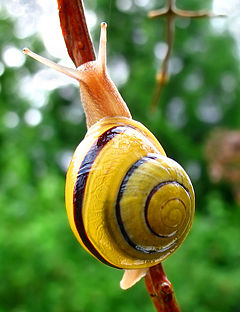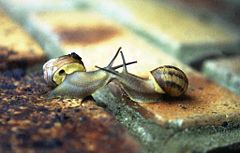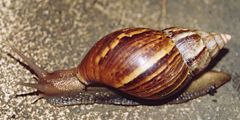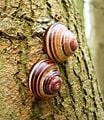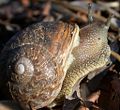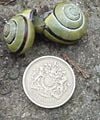Snail
| Snails | ||||||
|---|---|---|---|---|---|---|
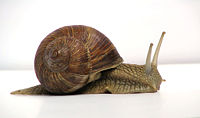 Roman snail (Helix pomatia)
| ||||||
| Scientific classification | ||||||
|
Snail is the common name applied to most members of the mollusk class Gastropoda that have coiled shells. Snails are found in freshwater, marine, and terrestrial environments. They are integral to food chains and, in addition to a number of species being consumed by humans as delicacies, snails also touch upon the inner nature of people, adding aesthetic value and contributing to the human fascination with nature, particularly with their unique shells and behaviors.
Gastropoda, the largest and most diverse class of the phylum Mollusca, has about 75,000 known living species. Most have a single shell that is characteristically coiled, such as snails, limpets, abalones, cowries, whelks, and conches. But there are also members that lack shells, such as slugs and sea slugs (nudibranches), and some that have shells with two halves. Gastropods are typically placed into two subclasses: Orthogastropoda ("true snails") and Eogastropoda ("true limpets") (Ponder and Lindberg 1997).
The term snail is not a taxonomic unit but is variously defined to include all members of Gastropoda, all members of the subclass Orthogastropoda, all members of Orthogastropoda with a high coiled shell, or a group of gastropods with shells that do not include limpets, abalones, cowries, whelks, and conches. "Slugs," which are gastropods that lack a conspicuous shell, are scattered throughout groups that primarily include "snails."
While most people are familiar with only terrestrial snails, the majority of snails are aquatic. Snails with lungs belong to the group Pulmonata, while those with gills form a paraphyletic group.
Biology
General characteristics
As with all mollusks, snails are characterized by having a true coelom; a body divided into the three parts of head, visceral mass, and muscular foot; and organ systems for circulation, respiration, digestion, excretion, nerve conduction, and reproduction (Towle 1989). Like other gastropods, their body plan involves a torsion or twisting during larval development whereby the visceral mass twists 180 degrees in relation to the head, bringing the mantle cavity to the anterior of the animal. Thus, the gills, and renal and anal openings are now near the front of the animal.
Snails range greatly in size. The largest land snail is the Giant African Snail or Ghana Tiger Snail (Achatina achatina; Family Achatinidae), which can measure up to 30 centimeters. Pomacea maculata (Family Ampullariidae), or Giant Apple Snail is the largest freshwater snail, with a diameter of up to 15 centimeters and a mass of over 600 g. The biggest of all snails is Syrinx aruanus, an Australian marine species which can grow up to 77.2 centimeters (30 inches) in length (COA 2007), and 18 kg (40lbs) in weight.
Most snails are of herbivorous nature, though a few land species and many marine species may be omnivores or carnivores. A snail breaks up its food using the radula. The radula is a chitinous structure, containing microscopic hooks, called cuticulae. With this the snail scrapes at food, which is then transferred to the digestive tract. This is why snails are often heard 'crunching' their food: the radula is tearing away at what they are eating.
Most snails bear one or two pairs of tentacles on their heads. In most land snails, the eyes are carried on the tips of the first set of tentacles (called ommatophores or more informally "eye stalks") which are usually roughly 75 percent of the width of the eyes. The second set of tentacles act as olfactory organs. Both sets of tentacles are retractable in land snails. The eyes of most marine and freshwater snails are found at the base of the first set of tentacles.
The cerebral ganglia of the snail form a primitive sort of brain, divided into four sections. This structure is very simple compared to the brains of mammals, reptiles, and birds, but snails are capable of associative learning (Sahley et al. 1982).
Snails move by alternating body contractions with stretching, with a proverbially low speed (1 millimeter per second is a typical speed for adult Helix lucorum) (Pavlova 2001). They produce mucus in order to aid locomotion by reducing friction. The mucus also reduces the snail's risk of injury. Snails also have a mantle that covers the internal organ that is called a foot.
The shells of snails and other mollusks, and snail egg casings, are primarily made up of calcium carbonate. Because of this, they need calcium in their diet and a watery environment to produce a strong shell. A lack of calcium, or low pH in their surroundings, can cause thin, cracked, or perforated shells. Usually a snail can repair damage to its shell over time if its living conditions improve, but severe damage can be fatal.
When retracted into their shells, some snails protect themselves with a door-like anatomical structure called an operculum. The operculum of some snails has a pleasant scent when burned, so it is sometimes used as an
As the snail grows, so does its calcium carbonate shell. A snail's shell forms a logarithmic spiral; most are right-handed, meaning that the whorl is on the right hand side of the shell. At some point, the snail builds a lip around the opening of the shell, stops growing, and begins reproducing.
The proportions of snail and nautilus shells are an example of the appearance of the golden ratio in nature. Patterns on shells of certain sea snails (Conus, Cymbiola) are similar to those formed by cellular automata.
Hibernation/Estivation
Some snails hibernate during the winter (typically October through April in the Northern Hemisphere). They may also estivate in the summer in drought conditions. To stay moist during hibernation, a snail seals its shell opening with a dry layer of mucus called an epiphragm. Some apple snails have a "door" to close the shell when they withdraw, for protection from predators as well as to avoid dessication.
Reproduction
All land snails are hermaphrodites, producing both spermatozoa and ova. Some aquatic snails, such as Apple Snails, are either male or female. Prior to reproduction, most snails will perform a ritual courtship before mating. This may last anywhere between two and twelve hours. Prolific breeders, snails inseminate each other in pairs to internally fertilize their ova. Each brood may consist of up to 100 eggs.
Snails have small slits on their necks where fertilization occurs and the eggs develop.
Garden snails bury their eggs in shallow topsoil primarily while the weather is warm and damp, usually two to four inches down, digging with their "foot"—the back of their "tail." Egg sizes differ between species, from a 3 millimeter diameter in the grove snail to a 6 centimeter diameter in the Giant African Land Snail. After two to four weeks of favorable weather, these eggs hatch and the young emerge. Snails may lay eggs as often as once a month.
The snail's shell develops while it is still an embryo; it is, however, very weak, and they need an immediate supply of calcium. Newly hatched snails obtain this by eating the egg they hatched out of. Baby snails cannibalizing other eggs, even unhatched ones, has been recorded.
Promptly after they are finished ingesting their egg casings, they crawl upwards through the small tunnel left from their parent digging their nest. At this stage, the young are almost completely transparent. Their shell is usually slightly smaller than the egg they hatched from, but their body length when out of their shell is slightly greater than the egg diameter. After a few weeks, the snails will begin to gain their first tinging, usually slightly blue before they turn their adult color. In roughly three months after they have hatched, they will look like miniature versions of their mature kin. They will continue to grow, usually for two to three years until they reach adult size, although there have been confirmed recordings of snails growing amazingly fast—even bigger than their parents in little more than a month. Irrespective of their rate of growth, it will still take two to six years before they are sexually mature.
There have been hybridizations of snails; although these do not occur commonly in the wild, in captivity then can be coaxed into doing so.
Parthenogenesis has also been noted in certain species (Ben-Ami and Heller 2005; Lively 1992).
Pond snails typically do not lay their eggs in the ground but carry them around until they hatch.
Lifespan
The lifespan of snails varies from species to species. In the wild, Achatinidae (family) snails live around five to seven years and Helix (genus) snails live about two to three years. Aquatic Apple Snails live only a year or so.
Most deaths are due to predators or parasites. In captivity, the lifespan of snails is much longer, ranging from ten to fifteen years for many species. On occasions, snails have lived beyond this lifespan, up to 30 years or more (Nordsieck 2007).
Diet
In the wild, snails eat a variety of different foods, including leafy vegetation, fruits, manure, and carrion. They can cause damage to agricultural crops and garden plants, and are therefore often regarded as pests. When kept as pets, snails will eat nearly anything, and snail owners should make sure which diets are appropriate for the species involved.
Predators
Snails have many natural predators, including members of all major vertebrate groups, decollate snails, ground beetles, leeches, and even the predatory caterpillar Hyposmocoma molluscivora. The botia family of freshwater fish also feed on freshwater snails by sucking them out of their shells.
Humans also pose great dangers to snails. Pollution and the destruction of habitats has caused the extinction and endangerment of a number of snail species in recent years.
Snails as food
Snails are eaten as food in some parts of the world. Although escargot is the French word for "snail," escargot on an English-language menu is generally reserved for snails prepared with traditional French recipes (served in the shell with a garlic & parsley butter).
In Europe, three varieties, all from the genus Helix, are ordinarily eaten:
- Helix pomatia, the Edible snail, prepared in its shell, with parsley butter.** Typical size: 40 to 55 mm for an adult weight of 25 to 45 g.
- Typically found: in Burgundy.
- Helix aspersa :
- Helix aspersa aspersa also known as the European brown snail, is cooked in many different ways, according to different local traditions.
- Typical size: 28 to 35 mm for an adult weight of 7 to 15 g.
- Typically found: Mediterranean countries (Europe and North Africa) and the French Atlantic coast.
- Helix aspersa maxima .
- Typical size 40 to 45 mm for an average weight of 20 to 30 g.
- Typically found: in North Africa.
- Helix aspersa aspersa also known as the European brown snail, is cooked in many different ways, according to different local traditions.
Achatina fulica, the Giant East African snail, is sliced and canned and sold to consumers as escargot. In parts of West Africa, snails are served as a delicacy. Achatina achatina, Ghana tiger snails, are also known as some of the largest snails in the world.
Snails are also popular in Portugal, where they are called "caracóis" (Portuguese for "snails"), and served in snack houses and taverns, usually boiled with garlic and oregano. Traditional Spanish cuisine is very fond of snails ("caracoles") also, consuming several species such as Helix aspersa, Helix punctata, Helix pisana, and Helix alonensis among others. Small to medium size varieties are usually cooked in several spicy sauces or even in soups, while the bigger ones may be reserved for other dishes, such as the "arroz con conejo y caracoles" (a paella-style rice with snails and rabbit meat, very popular in the inner regions of south-eastern Spain).
In Greece, snails are popular in the island of Crete. They are eaten either boiled with vinegar added or cooked in a casserole with tomato, potatoes and squashes. A third cooking method is the χοχλιοί μπουμπουριστοί traditional Cretan dish, which consists of fried snails in olive oil with lemon.
In Sicily, snails (or babbaluci as they are commonly called in Sicilian dialect) are a very popular dish as well. They are usually boiled with salt first, then served with tomato sauce or bare with oil, garlic, and parsley. Snails are similarly appreciated in other Italian regions, such as Sardinia.
Hélicicultures are snail farms.
Snails (or bebbux as they are called in Maltese) are a quite popular dish on the Mediterranean island of Malta.
Various snail species are also eaten in Asian cuisines as well.
Gallery
ReferencesISBN links support NWE through referral fees
- Ben-Ami, F., and J. Heller. 2005. Spatial and temporal patterns of parthenogenesis and parasitism in the freshwater snail Melanoides tuberculata. J. Evol. Biol. 18: 138-146. Retrieved April 26, 2007.
- Conchologists of America (COA). 2007. Frequently Asked Questions: Shells and the Animals That Make Them. Conchologistsofamerica.org. Retrieved April 26, 2007.
- Lively, C. M. 1992. Parthenogenesis in a freshwater snail: Reproductive assurance versus parasitic release. Evolution 46(4): 907-913.
- Nordsieck, R. 2007. The Roman snail or edible snail (Helix pomatia). The Living World of Mollucks. Retrieved April 27, 2007.
- Pavlova, G. A. 2001. Effects of serotonin, dopamine and ergometrine on locomotion in the pulmonate mollusc Helix lucorum. Journal of Experimental Biology 204(9): 1625-1633. Retrieved May 24, 2006.
- Ponder, W. F., and D. R. Lindberg. 1997. Towards a phylogeny of gastropod molluscs: An analysis using morphological characters. Zoological Journal of the Linnean Society 119: 83-2651.
- Sahley, C., A. Gelperin, and J. W. Rudy. 1982. One-Trial associative learning modifies food odor freferences of a terrestrial mollusc. Proceedings of the National Academy of Sciences 78(1): 640-642.
- Towle, A. 1989. Modern Biology. Austin, TX: Holt, Rinehart, and Winston. ISBN 0-03-013919-8.
External links
All links retrieved January 30, 2023.
Credits
New World Encyclopedia writers and editors rewrote and completed the Wikipedia article in accordance with New World Encyclopedia standards. This article abides by terms of the Creative Commons CC-by-sa 3.0 License (CC-by-sa), which may be used and disseminated with proper attribution. Credit is due under the terms of this license that can reference both the New World Encyclopedia contributors and the selfless volunteer contributors of the Wikimedia Foundation. To cite this article click here for a list of acceptable citing formats.The history of earlier contributions by wikipedians is accessible to researchers here:
The history of this article since it was imported to New World Encyclopedia:
Note: Some restrictions may apply to use of individual images which are separately licensed.
